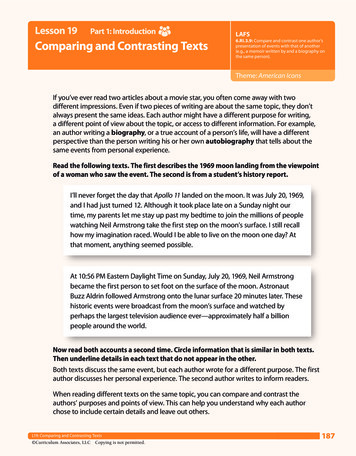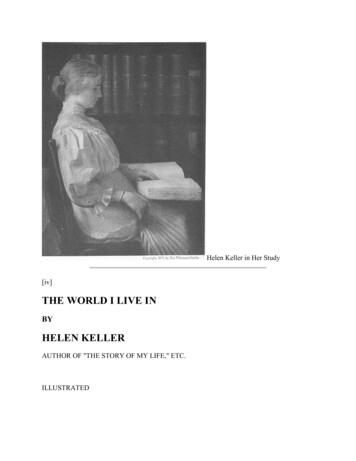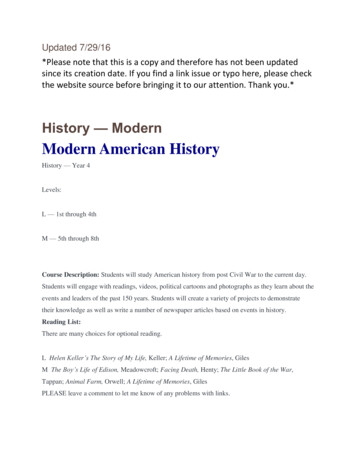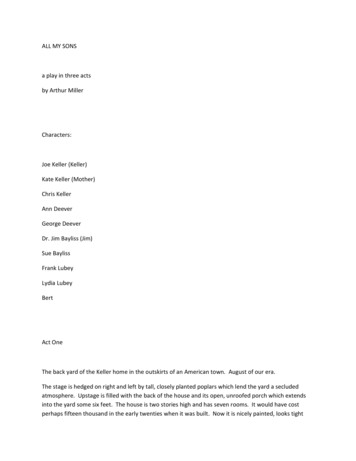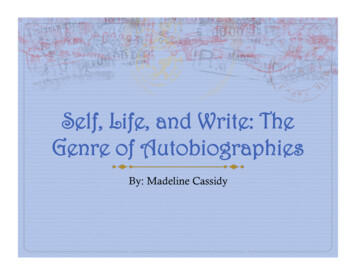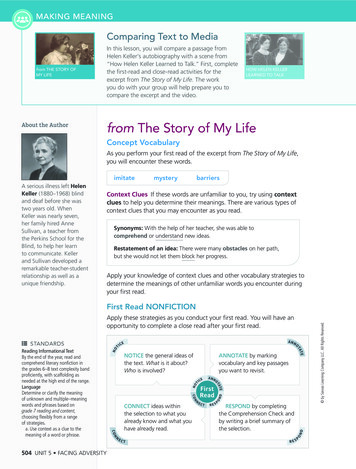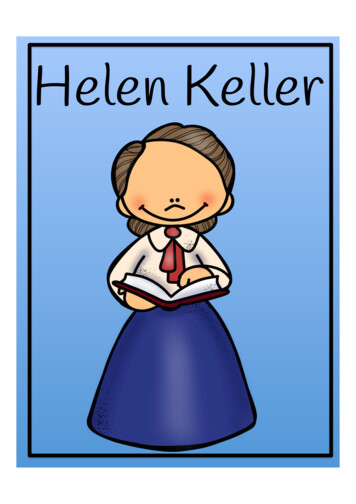
Transcription
Helen Keller
Abigail AdamsSusan B. AnthonyTyra BanksClara BartonHillary Rodham ClintonMarie CurieEllen DeGeneresDiana, Princess of WalesHelen KellerSandra Day O’ConnorGeorgia O’KeeffeNancy PelosiRachael RayEleanor RooseveltMartha StewartVenus and Serena Williams
Helen KellerActivistRachel A. Koestler-Grack
Helen KellerCopyright 2009 by Infobase PublishingAll rights reserved. No part of this book may be reproduced or utilized in any formor by any means, electronic or mechanical, including photocopying, recording, or byany information storage or retrieval systems, without permission in writing from thepublisher. For information, contact:Chelsea HouseAn imprint of Infobase Publishing132 West 31st StreetNew York, NY 10001Library of Congress Cataloging-in-Publication DataKoestler-Grack, Rachel A., 1973–Helen Keller: activist / by Rachel A. Koestler-Grack.p. cm. — (Women of achievement)Includes bibliographical references and index.ISBN 978-1-60413-502-2 (hardcover)1. Keller, Helen, 1880–1968. 2. Deafblind women—United States—Biography—Juvenile literature. 3. Deafblind people—United States—Biography—Juvenile literature. I.Title. II. Series.HV1624.K4K644 2009362.4’1092—dc22[B]2008055368Chelsea House books are available at special discounts when purchased in bulkquantities for businesses, associations, institutions, or sales promotions. Please callour Special Sales Department in New York at (212) 967-8800 or (800) 322-8755.You can find Chelsea House on the World Wide Web at http://www.chelseahouse.comSeries design by Erik LindstromCover design by Ben Peterson and Alicia PostPrinted in the United States of AmericaBang EJB 10 9 8 7 6 5 4 3 2 1This book is printed on acid-free paper.All links and Web addresses were checked and verified to be correct at the time ofpublication. Because of the dynamic nature of the Web, some addresses and links mayhave changed since publication and may no longer be valid.
Contents1Triumph over Silence2From Light into Darkness123Teacher224The Wonder Girl345Quest for College446Curious Triangle577Little Island of Joy698Bringing Light to the World85Chronology97Notes997Bibliography103Further Resources104Picture Credits105Index106About the Author111
1Triumphover Silence“Without language of some sort, one is not a humanbeing,” Helen Keller wrote in her autobiographyMidstream: My Later Life. “Without speech, one is nota complete human being.”1 For the first 10 years of herlife, Helen never spoke a clear word. The only sounds sheuttered were meaningless noises, usually harsh and piercing, because it took her such great effort to make them.Helen was deaf and blind. When she was just a toddler, shebecame deathly ill. She survived but lost her ability to seeand hear. As a child, she lived in a dark and silent world. Nosunlight woke her in the morning. No voice stirred her quietears. She existed almost in a fog—unable to form words andthoughts, never feeling the tickle of true happiness.
Helen KellerAll of that began to change when Helen was six yearsold. Annie Sullivan strolled up her front walk, ready to teachher. Sullivan opened up for Helen a whole new world, bursting with words, ideas, and emotions. Within three years,Helen could read and write better than many children herage who had not struggled with the challenges of blindnessand deafness. She could even “listen” to people by placingher fingers on their lips and reading their movements andvibrations as they spoke. Her incredible achievements madeher internationally famous. People around the world calledher a “miracle child” and “the eighth wonder of the world.”Helen was thrilled with her bright, enlightened life. She feltshe was able to do many of the things that people who seeand hear could do. Still, something was missing. She longedto talk like other people. She desperately wanted others tohear her speak.Sullivan took Helen to Sarah Fuller, the principal ofthe Horace Mann School for the Deaf and one of the pioneering teachers of speech in the country. Fuller began toteach Helen how to speak. She started with the word arm,which Sullivan spelled into Helen’s hand while Fuller saidthe word. Helen placed her hand on Fuller’s face and feltthe vibrations of her voice. Slowly and distinctly, Helenmade the sound “ahm.” She continued to imitate the sound,changing it ever so slightly, until Fuller was satisfied. Thatfirst day, Helen learned to speak several words in an airy,monotone voice.In the following lessons, Fuller helped Helen improveher speech tones. She tried to make Helen understandthat she must speak softly and not stiffen her throat orjerk her tongue. As hard as she tried, Helen had a difficulttime making her voice sound natural. For someone whocannot hear, learning how to talk is strenuous and tiring.Helen’s vocal cords had never been exercised for speech,
Triumph over Silence Helen Keller (left) posing with her doll and Annie Sullivan, the teacher whoenabled her to learn despite the fact that Keller could not see or hear,while on vacation in Cape Cod, Massachusetts, in July 1888.
10 Helen Kellerand controlling their movements took painful effort. Thelearning process was slow, but Helen refused to give up.For nearly a decade, Helen had been mute, unable toutter a single word. Back then, mute people were referredto as “dumb.” After just 11 lessons with Fuller, Helen wasable to say, word by word, “I am not dumb now.”2 WhenHelen first started to speak, few people could understandher. Sometimes only Sullivan and Fuller knew what she wastrying to say. After years of perseverance and determination,Helen was able to talk clearly enough for anyone to understand her. Helen’s triumph over the silence that imprisonedher is hard for a seeing and hearing person to appreciatefully. Speech comes easily for someone who can hear. Fora deaf person to learn natural speech, with its vast sounds,inflections, and tones, it is nothing short of a miracle.Overcoming AdversityAlthough Helen Keller never achieved her lifelong dreamof speaking completely clearly, she paved the way for othersto learn how to do just that. Against overwhelming oddsIn HER OWN WorDSSoon after her arrival, Annie Sullivan began to communicatewith Helen Keller by spelling words into Helen’s hands. Kelleronce said, as cited in Helen’s Eyes: A Photobiography of AnnieSullivan, Helen Keller’s Teacher:In her [Annie’s] fingers words rang, rippled, danced, buzzed,and hummed. She made every word vibrant to my mind—she would not let the silence about me be silent.
Triumph over Silenceand with unwavering perseverance, she grew into a highlyintelligent and sensitive woman who wrote, spoke, andworked incessantly for the betterment of the disabled.Keller changed the way people thought and felt aboutthe deaf and blind all over the world. She said, “The public must learn that the blind man is neither genius nor afreak nor an idiot. He has a mind that can be educated, ahand which can be trained, ambitions which it is right forhim to strive to realize, and it is the duty of the public tohelp him make the best of himself so that he can win lightthrough work.”3 11
2From Lightinto DarknessTo a child who has no sight or hearing, the pale blue skyon a sunny day, a vivid sunset of deep orange and red,the gold petals of a sunflower, the blare of a horn from apassing train, the trickling water of a stream, or a friend’scontagious giggle mean nothing. Helen Keller could notenjoy the sight of a delicate swallowtail as it rested fora moment on the head of a daisy. She did not have thecomfort of her mother’s soothing voice when she was sick.But she did not always live in that strange, dark world.When she was born on June 27, 1880, she was a healthychild, possessing the ability to see and hear. Her mothernamed her Helen, which means “light,” because she likedto imagine that her little girl’s life would be carefree andfull of brightness.12
From Light into DarknessFor almost two years, she lived like other children, playing in the sunshine on the lawn surrounding the Kellers’home, called Ivy Green, in Tuscumbia, a small, rural townin northwestern Alabama. Helen’s mother, Kate, whowas just 23 years old when Helen was born, doted on herdaughter. Kate Adams had grown up in Tennessee, as apampered southern belle. In 1879, she married 42-year-oldArthur H. Keller, a widower who had been a captain in theConfederate Army during the Civil War. Being nearly 20years younger, Kate had little in common with her newhusband, who had two grown sons from his first marriage.Kate got along quite well with the younger boy, a teenager,William Simpson. The older son, James, however, bitterlyresented his new stepmother. When Helen was born, itmust have been a relief for Kate. Now, she had her ownchild—someone to shower with love and affection.According to Helen, the beginning of her life wassimple and much like every other little life. “I came, I saw, Iconquered, as the first baby in the family always does,” shelater recalled in her autobiography The Story of My Life.1 Atsix months, Helen could call out, “How d’ye!” to visitors,and when she was thirsty, asked quite plainly for “Tea, tea,tea,” or “wah-wah” for water.2 On her first birthday, shetook her first steps. Kate had lifted her out of the bathtuband was holding Helen on her lap when Helen was suddenly attracted to the flickering shadows of leaves swayingin the sunlight on the floor. Helen slipped down off hermother’s lap and wobbled toward the dancing shadows. Assoon as the impulse disappeared, she fell with a thud andburst into tears.Those days of happiness and light did not last long. InFebruary 1882, Helen was only 19 months old when shebecame severely ill with what doctors at the time called“brain fever.” Her illness was most likely scarlet fever, a 13
14 Helen Kellerlife-threatening disease that is caused by streptococcusbacteria. Some modern doctors believe Helen’s symptomscould also have been caused by meningitis, an inflammation of the thin membranes that surround the spinal cordand brain. Whatever the mysterious illness, Helen’s doctorthought that she would certainly die. Miraculously, Helenrecovered and the Kellers breathed a sigh of relief. Noone, though, not even the family doctor, knew that Helenwould never see or hear again.Years later, Helen could recall only broken fragmentsof her illness, which seemed more like a nightmare to her.Helen recalled the tenderness of her mother as she tried tosoothe her sick daughter’s agony and fear. She rememberedher eyes being so dry and hot that she had to turn awayfrom the light, which grew dimmer and dimmer each day.“I was too young to realize what had happened,” Helenlater wrote, according to Helen Keller: A Life, by DorothyHerrmann. “When I awoke and found that all was dark andstill, I suppose I thought it was night, and I must have wondered why day was so long coming. Gradually, however, Igot used to the silence and darkness that surrounded meand forgot that it had ever been day.”3The “Little House”In the South, many homes had a small cottage near the mainhouse. At Ivy Green, Helen Keller’s birthplace, the one-roomcottage known as the “little house” was where Helen was born,and she lived there with her nurse until the time of her illness.
From Light into Darkness A recent photo of Ivy Green, Keller’s childhood home in Tuscumbia,Alabama. The clapboard house was built in 1820.Struggles of a New WorldWith her sight and hearing gone, Helen had to learn howto live in a whole new kind of world—one without light andsound. The Kellers realized that Helen was not the samewhen she remained unresponsive after Kate passed her handover Helen’s eyes and Helen did not react to the dinner bell.Those first few months after her illness, Helen felt scaredand alone. Terrified, she only wanted to sit on her mother’slap, and she clung to Kate’s dress as she went about herhousehold chores. Slowly, Helen began to venture out intothe darkness, running her hands over objects and following15
16 Helen Kellermotions with her fingertips. In this way, she learned toknow what many things were.Still, she felt the need for some kind of communication.She began to make crude signs as a way to talk. A shake ofher head meant “no,” and a nod was “yes.” A pull meant“come” and a push “go.” If she wanted a slice of bread, shewould imitate the act of cutting slices and buttering them.When she wanted ice cream after dinner, she made themotions of working the freezer and shivered. Most of thetime, Kate was able to understand Helen and rushed to giveher whatever she wanted.Because of Helen’s severe disability, her parents couldnot bear to discipline her. As she grew older, she becameextremely frustrated at not being able to communicate. Helenrealized that she was different from other people, because hermother and her mother’s friends communicated withoutsigns when they wanted something. They talked with theirmouths. Sometimes Helen stood between two people in aconversation and touched their lips while they talked. Helenwould move her lips, but nothing happened. “This mademe so angry at times that I kicked and screamed until I wasexhausted,” she later wrote in The Story of My Life.4Helen was strong-willed and petulant. Her fits of rageand wild behavior terrorized the household. She deliberately broke dishes and lamps and stuck her hands intoplates of food. Once she charged into the parlor in her redflannel underwear and repeatedly pinched her maternalgrandmother until she chased the older woman from theroom. Because Helen’s disabilities prevented her from seeing or hearing people’s reactions, she did not know that heractions were hurting her family. Some relatives called her“a monster,” and one of them suggested that Helen be sentoff to an institution.Kate was overwhelmed by her challenges with Helen.She had adored her darling girl with soft, golden curls and
From Light into DarknessHelen Keller at age seven, around the time Annie Sullivan cameto educate her.pale blue eyes when she could see and hear. After Helen’sillness, however, Kate began to feel guilty, frustrated,and helpless. She did not know how to deal with Helen’sdisruptive outbursts. Still, she refused to send her child 17
18 Helen Kelleraway, no matter how desperate the situation becameat home.When Helen was five years old, Kate gave birth to asecond girl, Mildred. In a fit of jealousy, Helen overturnedher little sister’s cradle, causing Mildred to fall out; hadKate not caught her as she tumbled out of her bed, Mildredmight have died. In time, though, the sisters became friends.“Mildred and I grew into each other’s hearts,” Helen laterBell’s Talking DogAlthough best known for inventing the telephone, AlexanderGraham Bell contributed much to the education of the deafand blind. Despite being normally quiet and introspective as achild, he enjoyed experimenting in mimicry and “voice tricks”such as ventriloquism—the art of projecting one’s voice so thatit seems to come from another source, like a wooden figure.Bell was also deeply affected by his mother’s gradual deafness (she began to lose her hearing when he was 12), and helearned a manual finger language so he could communicatewith her. He also developed a technique of speaking in clear,precise tones, directly in front of his mother’s forehead, inwhich she could understand him quite well. Bell’s preoccupation with his mother’s deafness led him to study acoustics—thescientific study of sound, especially of its generation, transmission, and reception.Bell’s family had an interest in the teaching of elocution,the art of public speaking. His grandfather, uncle, and fatherwere all elocutionists. His father published a number of workson the subject, including The Standard Elocutionist. In this book,his father explained his methods of how to instruct deaf-mutes(as they were then known) to articulate words and read other
From Light into Darknesswrote, “although she could not understand my finger language, nor I her childish prattle.”5Finding HopeDay after day, Helen’s desire to express herself grew. Thefew signs she had used as a child became less and lessadequate. She felt trapped and desperately wanted to beunderstood. “I felt as if invisible hands were holding me,people’s lip movements. Bell’s father taught him how to readlips. The boy was so proficient that he became a part of hisfather’s public demonstrations. He astounded audiences with hisabilities to read speech in other languages.Bell’s father encouraged his interest in speech. In 1863, hetook Bell to see an automaton, or what would today be calleda robot. This “mechanical man” could simulate a human voice.Bell was fascinated by the machine and afterward he and hisolder brother, Melville, built their own automaton head. Theirremarkably lifelike head could “speak,” even if it was only a fewwords. The boys would carefully adjust the lips and when one ofthem forced air through the mechanical windpipe, a very recognizable “mama” sound came out.Pleased with his results, Bell continued to experiment—thistime with a live subject, the family dog. After he taught it togrowl continuously, he would reach into its mouth and manipulate the dog’s lips. Eventually, he managed to produce a crudesounding “Ow-ah-oo-ga-ma-ma.” With a little convincing, hecould make an audience believe his dog could speak the phrase“How are you, grandma?” Bell’s talking dog experiment inspiredhis work to teach the deaf to speak. 19
20 Helen Kellerand I made frantic efforts to free myself,” she wrote yearslater.6 Helen’s outbursts became more and more frequent.By the time she was six years old, her fits of frustrationerupted daily, sometimes hourly.Helen’s parents frantically searched for some way tohelp their daughter. In 1887, Kate found a ray of hope ina book by Charles Dickens, called American Notes. In thebook, which was an account of his trip to North America in1842, Dickens wrote about meeting a deaf and blind womannamed Laura Bridgman, who had been taught to read andwrite. However, the man who had educated Laura, Dr.Samuel Gridley Howe, had died a decade earlier. Even if histeaching methods had been documented, who would cometo far-off Alabama to teach her little girl? The Kellers livedfar from any school for the blind and the deaf.Kate and Arthur Keller took Helen to see numerouseye specialists in Alabama and Tennessee, but none ofthem could help the child. At last, one specialist arrangedfor them to meet with the famous ophthalmologist Dr.Julian Chisholm in Baltimore, who specialized in curing“hopeless” cases. At the consultation, the doctor told theKellers that there was nothing medically that could bedone to cure their daughter. In his opinion, though, theyshould not give up hope. He believed Helen could betaught, just like Laura Bridgman.“There’s a gentleman in Washington, a short distanceaway, who is an expert on the problems of deaf children,”Dr. Chisholm explained. “Perhaps he can help you finda school or teacher for your little girl.”7 The man wasAlexander Graham Bell, who had invented the telephonein 1876. Bell’s interest in the deaf was not just scientific.His mother, Eliza, became deaf and could hear only withthe help of an ear tube. His wife, Mabel, had lost her hearing at the age of five from scarlet fever. When Mabel was
From Light into Darkness16 years old, Bell became her private tutor, and they married several years later.At Bell’s office in Washington, the inventor pickedHelen up and set her on his broad knee. He took out hispocket watch and placed it in her tiny hand. She smiledwhen she felt the vibrations the watch made when it struckthe hour. At the time, young Helen did not know aboutBell’s devotion to teaching the deaf. All she knew was thathe understood her signs, and she “loved him at once.” Histouch was tender and sympathetic. “I did not dream thatthat interview would be the door through which I shouldpass from darkness into light, from isolation to friendship,companionship, knowledge, love,” she later wrote in TheStory of My Life.8Bell suggested that the Kellers write to Michael Anagnos,who had become the director of the Perkins School for theBlind, the position Dr. Howe had held before he died. Atthe institution, teachers were trained to educate the deafand blind through Dr. Howe’s methods. When Anagnosreceived the Kellers’ letter, he reviewed the list of hisrecent graduates for a possible teacher for Helen. Onename jumped immediately to mind. She had no experienceas a teacher, either of the hearing and sighted, the blind,or the deaf and blind, but as a child, she had suffered fromtrachoma, an eye disease that had left her partially blind.Despite her visual impairment, she was his star graduate,well trained in Howe’s methods. Brilliant, passionate, andpersevering, 20-year-old Anne Sullivan seemed like theperfect match for the headstrong Helen. 21
3Teacher“The most important day I remember in all my life isthe one on which my teacher, Anne Mansfield Sullivan, came to me,” Helen Keller wrote in The Story of MyLife.1 On March 3, 1887, Helen, then nearly seven, stoodon her front porch, waiting for something to happen butunsure of what it was. She could tell by the way her motherhurried around the house that someone important wascoming. Outside, Helen tipped her face upward and let thewarm beams of sunshine sprinkle on her cheeks.Suddenly, she felt the vibration of approaching footsteps. Assuming it was her mother, Helen stretched outher hand. Someone else took it and pulled Helen into herarms. Knowing it was not her mother, Helen franticallystruggled to free herself. The young woman trying to hold22
Teacherlittle Helen was Annie Sullivan, but Helen would come toknow her as Teacher.Sullivan was pleased when she saw that Helen was ahealthy, sturdy girl. Because many blind children she hadseen were physically frail, Sullivan had expected Helen tobe a pale, delicate child. She studied Helen’s face closely.“It is intelligent, but lacks mobility, or soul, or something,”she wrote in her journal.2 With Helen’s chilly reaction toher hug, Sullivan decided that her first plan was to win thechild’s love.Almost immediately, Sullivan realized that she had herwork cut out for her. The next day, she witnessed one ofHelen’s wild tantrums firsthand. When Sullivan tried tocalm her down, Helen kicked and flailed, knocking out oneof Sullivan’s front teeth. One morning at the breakfast table,Helen reached over to eat something off Sullivan’s plate,as she did with other members of her family. Sullivan wasappalled by Helen’s rude table manners. When she refusedto let Helen grab food from her plate, Helen flung herselfonto the floor with screams, twists, and flops. Sullivanasked the Kellers to leave the room and locked the doorbehind them. Then she sat back down at the table andcontinued to eat her breakfast while Helen rolled aroundon the floor. At one point, Helen tried to jerk Sullivan’schair out from beneath her. Finally, Helen decided to getup and find out what Sullivan was doing. Sullivan let Helenfeel that she was eating but would not let the child fingerher food. Frustrated, Helen pinched Sullivan, who slappedthe girl’s hand each time she pinched. Curious as to whyher mother let Sullivan slap her, Helen walked all aroundthe table and found no one there. At last, she came back toher chair and began to eat her breakfast with her fingers.Sullivan gave her a spoon, which Helen threw on the floor.Determined to teach Helen good manners, Sullivan forced 23
24 Helen Kellerthe little girl to pick it up. After a few minutes, Helen gaveup fighting and finished her breakfast in peace. The ordealwas intensely emotional for Sullivan. After Helen finishedeating, Sullivan let her go outside to play and went up to herroom, where she threw herself on her bed. “I had a good cryand felt better,” she wrote.3Sullivan realized that, if she wanted to reach Helen, shewould have to get the girl away from her family. For years,Captain Keller and Kate Keller had given Helen whatevershe wanted. In order to teach Helen, Sullivan needed to discipline the unruly child. The Kellers agreed to let Sullivanuse the small cottage next to the house, where the teacherand student would live. Sullivan had the furniture rearranged so the room would be unfamiliar to Helen. Thenshe took Helen for a carriage ride to make her believe theywere going to a different place. Helen’s family could visitthem every day, but they were not allowed to let Helenknow they were there.The first day was a disaster. Helen kicked and screamed,refusing to let Sullivan touch her. That night, Sullivan haddifficulty getting Helen to go to bed. Finally, after a twohour struggle, Helen fell asleep. “I never saw such strengthand endurance in a child,” Sullivan wrote in a letter. “Butfortunately for us both, I am a little stronger.”4Undaunted by Helen’s tantrums, Sullivan persisted inteaching Helen to spell. Sullivan had begun this task assoon as she arrived at the Kellers’ home. She placed a bigrag doll on Helen’s lap. Sullivan slowly spelled the word“d-o-l-l” in Helen’s hand. At once, Helen became curiousby this new finger play and tried to imitate it. When shefinally succeeded in forming the letters correctly, she randownstairs to her mother, held up her little hand, and madethe letters for the word doll. At the time, Helen did notunderstand that she was spelling a word. She was simplymaking her fingers copy what Sullivan had done. In the
Teacher The water pump at Ivy Green that enabled Annie Sullivan to teach youngHelen the word for water.days that followed, Helen learned to spell many words,such as pin, hat, cup, sit, stand, and walk, but she still did notunderstand what they meant.A Soul Set FreeOn April 5, 1887, the cloud was lifted from Helen’s mind,and a miracle occurred. While Helen was playing with anew doll, Sullivan also set the rag doll on Helen’s lap andspelled doll. She tried to make Helen understand that theword doll applied to both objects. Earlier that morning,25
26 Helen KellerSullivan had tried to teach Helen the difference betweenthe words mug and water. Sullivan showed Helen that amug was something that held water, but Helen was confused. She thought both words meant the same thing. Shedid not know the word for drink, so whenever she spelledmug or milk, she made a pantomime of drinking something.That morning when Helen was having a bath, Sullivan triedto teach her the word water. She spelled “w-a-t-e-r” intoHelen’s hand. Later in the day, Helen and Sullivan stoppedat the water pump between the house and the cottage. Sullivan made Helen hold a mug under the spout while shepumped. As the cold water poured over the top of the mug,Sullivan spelled “w-a-t-e-r” in Helen’s free hand.An expression of revelation lit Helen’s face. She wascoming to life—the mystery of language was revealed.This new understanding seemed to startle her, and shedropped the mug. At that moment Helen knew that“w-a-t-e-r” meant the cool liquid flowing over her hand.She later wrote, “That living word awakened my soul,gave it light, hope, joy, set it free!”5 She spelled out waterseveral times. Next, she pointed to the pump, urgingSullivan to tell her its name. Then, suddenly, she turnedto Sullivan and asked for her name. Sullivan spelled“T-e-a-c-h-e-r.” All the way back to the house, Helenlearned the name of every object she touched. In just a fewhours, she added 30 words to her vocabulary.“It would have been difficult to find a happier child thanI was as I lay in my crib at the close of that eventful day andlived over the joys it had brought me,” Helen later wrote,“and for the first time longed for a new day to come.”6Helen remembered practically nothing about her lifebefore Annie Sullivan arrived. “Before my teacher came tome, I did not know that I am. I was a phantom living in ano-world,” she wrote about those earlier years of her life. “Ihad neither will nor intellect. I was carried along to objects
Teacherand acts by a certain blind natural impetus. . . . My innerlife, then, was a blank without past, present, or future, without hope or anticipation, without wonder or joy or faith.”7For Helen, her life really began at age six, after she learnedthe meaning of words.It took some time, but Helen slowly developed a moregentle personality. She began to understand that her actionsaffected the people around her. Several months after theincident at the water pump, Helen had another one of hertantrums. Sullivan was out of the room when it started.Viney, the child of one of the servants, noticed Helen fillingup a glass with stones. Worried that the glass would break,she snatched it away. At once, Helen began to tear at Viney,scratching and biting her like a wild animal. Hearing theruckus, Sullivan rushed in, grabbed Helen’s hand, and askedher what had happened. Helen spelled “Viney—bad” andresumed her attack with slaps and kicks. Sullivan held bothof Helen’s arms tightly until she calmed down.Later, Helen came into Sullivan’s room looking sad.She wanted Sullivan to give her a kiss. Sullivan told her,“I cannot kiss naughty girl.” Helen spelled back, “Helen isgood, Viney is bad.” Sullivan pointed out that Helen hadstruck and kicked Viney and hurt her. She explained thather behavior was naughty and refused to give Helen a kiss.Helen stood very still, her face flushed and troubled. It wasobvious that there was a struggle going on in her mind.“Helen does not love teacher. Helen do love mother,” shespelled. “Mother will whip Viney.”8 Sullivan told her thatshe should not talk about it anymore but think about it, andshe left Helen to sit by herself.At the dinner table, Helen became worried whenSullivan would not eat. Sullivan told Helen that her heartwas sad and that she was not hungry. Helen began to soband clung to Sullivan. Finally, she threw her arms aroundSullivan’s neck and said, “I will be good tomorrow. He
being,” Helen Keller wrote in her autobiography Midstream: My Later Life. “Without speech, one is not a complete human being.”1 For the first 10 years of her life, Helen never spoke a clear word. The only sounds she uttered were meaningless noises, usually harsh and pierc
